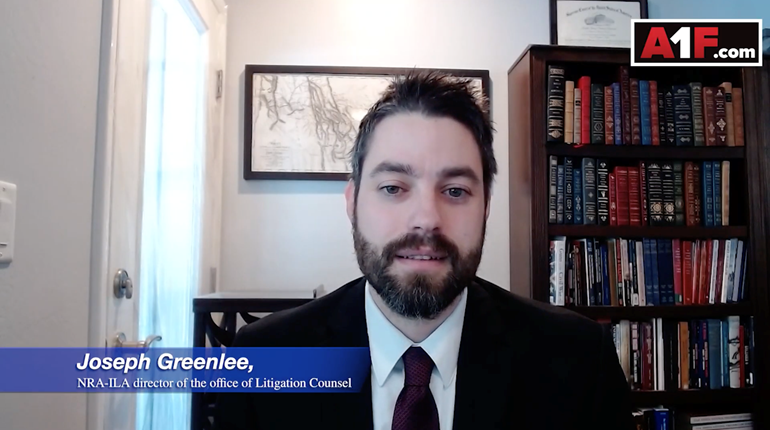
When it becomes clear that a popular change in state law does something fundamentally good for citizens’ freedom without doing harm, it becomes much easier to get legislators to do the right thing. This is part of the reason for the quick spread of constitutional-carry laws, which now cover half of the states, as of press time. (A state is “constitutional carry” if a law-abiding adult who can legally possess a handgun does not need a permit to carry that handgun concealed for lawful protection.)
Another part of the reason for the fast spread of constitutional-carry legislation is the NRA Institute for Legislative Action’s (ILA) team, which has worked across America to bring the facts to state legislators. They have been so effective that a majority of state legislators in Alabama, Georgia, Indiana and Ohio most-recently opted to get their state’s bureaucracies out of the way of their law-abiding citizens’ Second Amendment rights.
An underlying reason this has been an effective push is the basic fact that law-abiding American citizens are not problems that needs to be solved. Despite what the Biden administration argues, armed citizens help to keep individuals safer. Nevertheless, each time a constitutional-carry law comes up for debate, gun-control groups argue that getting the government out of the concealed-carry-license business will result in “Wild West-style shootouts” on the streets. But each time these laws pass, the data clearly shows that doesn’t happen.
This has been a big change from a few decades ago when Vermont was the sole state with constitutional carry. The term “constitutional carry” comes from legal history; when the Second Amendment was adopted in 1791, constitutional carry—either open or concealed—was lawful in every state.
Still, as more and more states return to the original understanding of the right to bear arms, opponents warn that constitutional carry (or “permitless carry”) will cause murder rates to increase; for example, Eugenio Weigend, director of the Gun Violence Prevention program at the Center for American Progress, says that constitutional carry will “raise some confrontations in some places, further escalating violence to reach lethal levels.” Michael Bloomberg’s anti-gun group Everytown for Gun Safety says states that have moved toward constitutional carry are “abandoning core public safety standards.”
While Vermont has long had constitutional carry, thanks to the 1903 state supreme court decision State v. Rosenthal, the move toward constitutional carry in the 21st century started with Alaska in 2003.
In this article, we present the data about what actually happened when states adopted constitutional carry. The data comes from a report co-written by Alexander Adams and Colorado State University Professor Youngsung Kim. (The data and code are available at: https://github.com/K-Alexander-Adams/Am1st)
Except for Vermont, all the states that currently have constitutional carry already had “shall-issue” licensing systems for concealed carry. That is, applications for concealed-carry permits could not be denied simply because the licensing official did not like citizens carrying firearms.
So, why did the NRA work for constitutional carry in those states? Because even a fairly administered shall-issue system can take weeks or months for a license to be issued. The delays can leave the innocent defenseless for too long; this is especially true for victims of stalkers and for people fleeing domestic violence. The same is true when civil order breaks down, such as during riots or natural disasters—times when law enforcement is often overwhelmed. Some licensing offices, for example, shut down or slowed down during the COVID-19 pandemic.
Even when a state statute sets up a fair process for licensing, local governments can find ways to manipulate the system to delay applications. This has been a long-standing problem in Denver, and is one reason why civil-rights activists are fighting for constitutional carry in Colorado.
A second reason for constitutional carry is cost. To some people, spending a few hundred dollars for fees, fingerprints and so on is no big deal. But for lower-income people, the financial barrier of a licensing system can be severe to prohibitive. Constitutional carry also eliminates the possibility of bias against any racial, gender or socio-economic groups in the permitting process.
Even in constitutional-carry states, many people still choose to obtain permits. Permits make it easier to carry in other states when traveling, because many states have laws that recognize the permits issued by some or all other states. Depending on state law, a permit may allow carrying in some places where constitutional carry is not allowed.

How Does Constitutional Carry Impact Crime?
How can we determine the effects of constitutional carry? One approach would be to just compare current crime rates in states with and without constitutional carry; for example, Vermont, with constitutional carry, has much less crime than neighboring New York, which does not. The same is true for Utah versus Colorado. But skeptics would accurately point out that other differences between the states could account for the differences in crime rates. Portions of New York, for example, are more urbanized than Vermont.
Further, because crime rates change over time, looking at several years is more revealing than just a single year.
To get answers, Adams and Kim studied all 50 states and the District of Columbia from 1980 to 2018. Their study also accounted for 30 control variables—that is, factors other than constitutional carry that might raise or lower a state’s crime rate. The control variables included population density, alcohol consumption, poverty rates, unemployment rates, the Fryer crack-cocaine index, incarceration rates, age cohorts in five-year blocks from age 15 to over 65 years of age, police per capita, other gun control (such as “assault-weapons” bans), racial variables and more.
To show how important it is to consider control variables, we will first show you the results without them, and then the results with the control variables included.
Here is a short explanation on how to read the tables. Suppose you flipped a coin 100 times, and 65 of those times, it came up heads. Does that prove the coin was biased (unevenly weighted), or could the results just be random chance? In social science, the probability that the result was not due to chance is called “statistical significance.” In the tables, if there is less than a 1% chance the result is due to chance, the result has three asterisks. If the probability that a result is random is less than 5%, there are two asterisks. If less than 10%, there is one asterisk. Traditionally, statisticians use the 5% cut-off to call something “statistically significant,” but they also report results for 1% and 10%. We do the same.

Below each result, in parentheses, are the “standard errors.” The standard errors measure how far the average data point—in this case, a state’s homicide or suicide rate in a given year—falls from the regression line. Imagine a scatter plot through which you draw a line of best fit. The messier the plot looks, the higher the standard error is in relation to the result; the cleaner and tighter the points are to that line, the lower the standard error is in relation to the result. Standard errors are important since they are used in the calculation of statistical significance.
“R-squared” is a measure of how strong the correlation is between the variables in the model and the outcome we are studying. It is measured from a scale of 0 to 1, with “1” meaning the model captures everything and “0” meaning the model has no relationship with what you are studying at all. In this case, an R-squared close to 1 means the model explains nearly all of the differences in homicide/suicide levels and trends between states, whereas a low R-squared means the model does not explain a lot.
Observations in the table simply represent how many data points are in the model. One state in one year is a single observation. Given the number of states plus D.C. (51), and the number of years the dataset spans (39), there should be 1,989 observations. Some of the regressions have fewer observations than that; this is because if there is missing data, the observation is dropped.
Now look at Table 1. It shows effects of state-law changes to adopt constitutional carry, and state-law changes to adopt shall-issue permits.
In Table 1, there are many statistically significant results from state adoption of constitutional carry and of shall issue. We see statistically significant decreases in homicide and statistically significant increases in suicide. Some of the data in this table would in fact be ripe for misinterpretations by those who would like to paint shall-issue and constitutional-carry in an unfavorable light. Remember, Table 1 does not account for other social factors, such as urbanization, illegal drug use and so on.

Now let’s take all 30 independent variables into account. The results are in Table 2. Once the independent variables are considered, the effects of different carry laws shrink dramatically—by at least an order of magnitude. Whatever positive or negative effects of the laws, they are about 1/10th the size (or even smaller) compared to Table 1, which ignored social variables. In Table 2, almost all of the statistically significant results disappear after other social variables are accounted for.
The data clearly show there is no statistically significant relationship between constitutional-carry laws and homicide. There was likewise no association with firearm homicide rates. The predictions of doom and gloom have not been statistically validated, at least as far as this analysis goes.
In fact, the relationship between constitutional-carry laws and homicide is negative, which is the opposite of what gun-control activists have predicted. Constitutional-carry laws were associated with about 6% lower homicide rates; but, again, the result was not statistically significant. In other words, we cannot be 99%, 95% or 90% sure that this happy result was not due to chance.
For suicide, there is a positive association between constitutional carry and suicide rates, but it is not significant at the traditional 5% level. Although it is significant at the looser 10% level, there are reasons to believe this result is not due to constitutional carry. If constitutional carry were going to affect suicide, then it would affect suicide by firearm. It is impossible to believe that someone who was lawfully carrying a firearm without a permit would be, because of the firearm, more likely to jump out of a window or drive a car off a bridge. The only way that constitutional carry could affect suicide would be by increasing suicide by firearm—and the results on firearm suicide are not statistically significant.
The bottom line, based on what social science can measure, is that constitutional carry does not lead to large-scale change in homicides or in firearm suicides. The doomsday scenarios of constitutional-carry opponents are not supported by social science.
It is certainly true that constitutional carry can make a difference in individual cases. The 2021 National Firearms Survey, by Georgetown professor William English, suggests there are 1.67 million defensive gun uses each year, each representing an incident of resistance to homicide, rape, robbery, assault or other crime. Obviously, an unknown subset of these defensive uses may be attributable to constitutional carry.
For all crimes, successful self-defense is certainly significant to the people involved. When a woman saves her children from a carjacker, it is of the utmost importance to that family. It’s just that these cases do not happen often enough to create a statistically significant difference in homicide rates. (The Kim and Adams study did not analyze other crimes, such as rape or robbery.) Similarly, for firearm suicide, the laws might have had an effect in individual cases, but not often enough for social scientists to be confident that the results are not due to chance.
If you don’t care about statistical significance, then constitutional carry’s raw benefit (homicides down by 6%) is larger than its harmful effect (firearm suicides up by 3%). Again, every death is significant to those involved, but ultimately, the data indicate more lives may be saved.
It should be noted that the CDC database used in this study does not distinguish criminal homicides from lawful defensive homicides. So the very small increase in firearm homicide (0.6 of 1%) is consistent with an increase in lawful defensive shootings leading to a lower overall murder rate; such as one dead carjacker instead of three dead children and one dead mother.
Gun-control advocates predict increases in murders with constitutional carry, but the data says otherwise. Self-defense is a natural right. That right can be restricted when there is a strong reason to do so; for example, people confined in prisons are not allowed to possess firearms. But, the opponents of constitutional carry across society have not met their burden of proof.


































